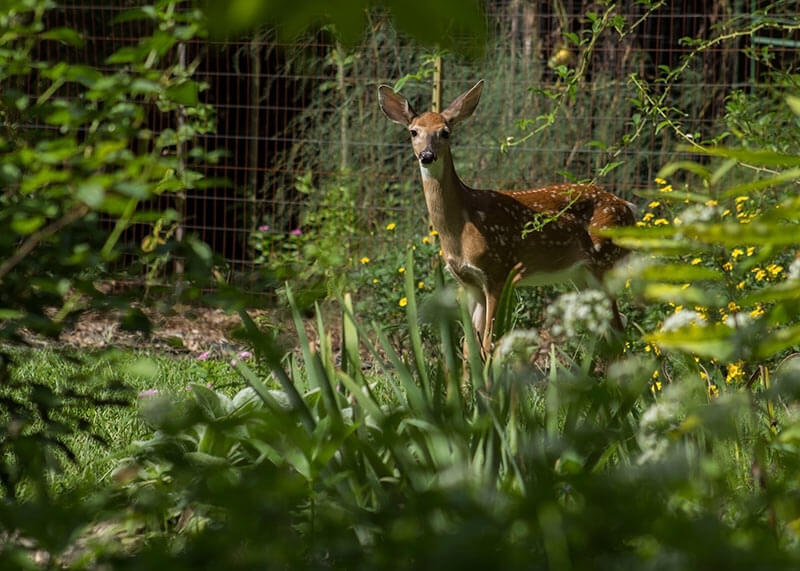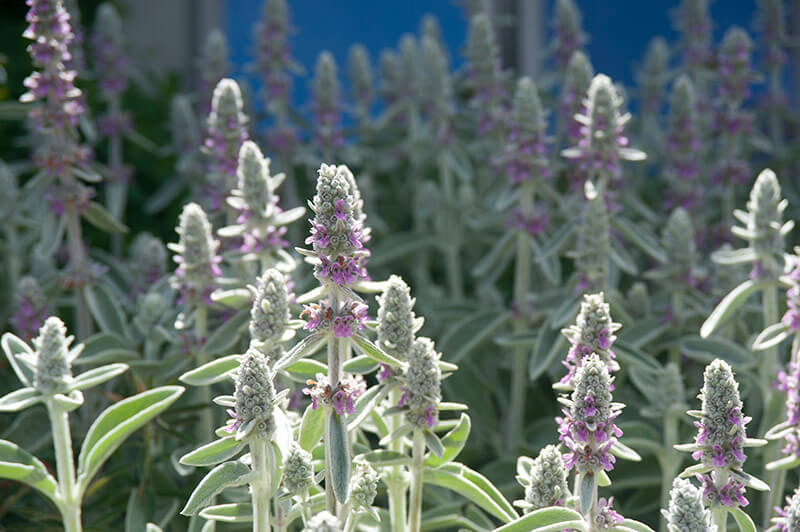Managing Deer in Home Landscapes
Seeing deer in your yard can be a beautiful encounter with nature — until you realize they are headed for your plants. After a winter of limited food supplies, browsing deer see your tender, long-awaited azalea buds and emerging hostas as inviting springtime buffets. During summer drought, destruction intensifies as deer turn to lush, irrigated landscapes and productive vegetable gardens for treats. In areas stricken with Lyme disease-transmitting deer ticks, visits from deer bring added troubles, in the form of increased risk of the disease.
Once deer learn that your landscape holds a variety of tasty plants, managing potential damage can be challenging. You can minimize deer visits and limit deer-related destruction with this three-part strategy:
- Landscape with deer-resistant plants.
- Use deer repellents regularly.
- Exclude deer with netting or fencing.

1. Landscape with deer-resistant plants.
Hungry deer will eat almost any plant, but they have distinct preferences when given options. By landscaping with plants that deer find unappealing, your yard and gardens become far less attractive to deer.1 Deer tend to avoid eating plants with the following characteristics:
- Strongly scented foliage. Lavender and other aromatic herbs fall in this group.
- Leathery leaves. Deer rarely eat forsythia, honeysuckle and similar shrubs.
- Fuzzy leaves. Lamb's ears, woolly thyme and other hairy plants are low on deer menus.
- Prickly stems and leaves. Deer avoid barberries and cacti, but roses are thorny exceptions. Deer seek them out and eat them in spite of their pricks.
Simple changes in your plant choices reduce deer traffic and increase the longevity of your plants.2 Replace deer favorites such as arborvitae with junipers, pines or other evergreens. Trade out tender-leaved, shade-loving hostas for colorful ferny alternatives, such as Japanese painted fern and bleeding hearts. Forget about planting tulips, a preferred spring snack for deer. Choose daffodil bulbs instead; deer avoid them. Planting close to your home or high-traffic walkways also cuts down on potential browsing.

2. Use deer repellents regularly.
Mechanical deterrents such as motion-activated water sprinklers or lights scare deer away for a time, but deer have a fast learning curve and realize there's nothing to fear. However, repellents applied directly to plants deer browse are very effective. Deer quickly learn to avoid unpleasant smells, tastes and textures.
Deer repellents fall into two main categories: area repellents and contact repellents. Area repellents work through foul smells that cause deer to avoid entire areas. Contact repellents work primarily by taste; deer take a bite and soon regret it. Many commercial area repellents include eggs or sulfurous products that smell like rotten eggs, an odor that deer dislike intensely. Effective contact repellents frequently include hot peppers or hot pepper sauces. Most repellents must be reapplied frequently, particularly after rainfalls, to stay effective.
Colorado State University researchers report that one of the most effective deer repellents can be whipped up right in your own kitchen. A mixture of 20 percent whole chicken eggs and 80 percent water, sprayed onto plants, is highly effective in repelling hungry deer.1 (Remove the small bright white membranes connected to egg yolks before mixing to prevent sprayer clogs.) Reapply this weather-resistant mix about once per month.1
Hot pepper sauces or ground hot peppers mixed with water can also be effective repellents. In general, the higher the hot pepper percentage in the mixture, the greater its effectiveness.
3. Exclude deer with netting or fencing.
The closest you'll get to a deer-proof garden is physically preventing deer from entering or eating. Protect individual plants with netting or burlap to prevent deer from eating foliage. Plastic tubing designed to fit around tree trunks prevents deer from damaging bark — especially during the season when male deer rub against trees to remove the velvety covering on antlers.
Fencing that keeps deer outside your boundaries is the surest way to prevent deer damage. Some homeowners fence entire properties, while others focus on vegetable gardens and other deer-prone areas. Deer fences must be secure to the ground and at least 8 feet tall to prevent deer from jumping over or crawling under.1 Fencing is most effective when put up before planting a new garden, so that deer never experience the tastes within. Your local county extension agent can help with recommendations for effective deer fencing options to suit your situation and deer populations in your region.
Sharing the countryside with deer doesn't have to mean sacrificing your landscape. Through wise plant choices, effective repellents and protective fencing, you can reduce deer damage or prevent it all together. Amdro and the full line of Amdro pest control products, including highly effective controls for Lyme-transmitting deer ticks, are dedicated to helping you protect your home and landscape from unwanted deer and other pest disruptions.

Amdro is a registered trademark of Central Garden & Pet Company.
Sources:
1. Swift, C.E. and Gross, M.K., “Preventing Deer Damage," Colorado State University Extension, October 2014.
2. New Jersey Agricultural Experiment Station, “Landscape Plants Rated by Deer Resistance," Rutgers University.




